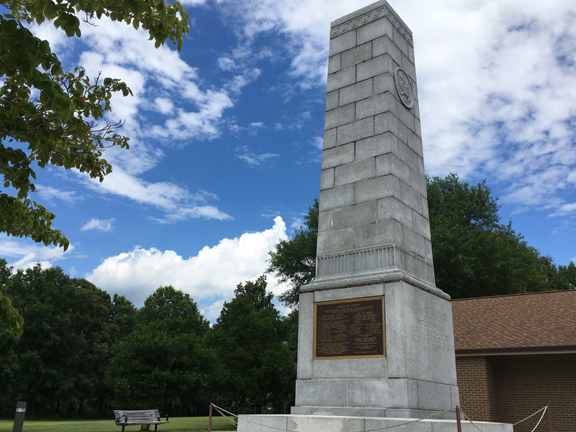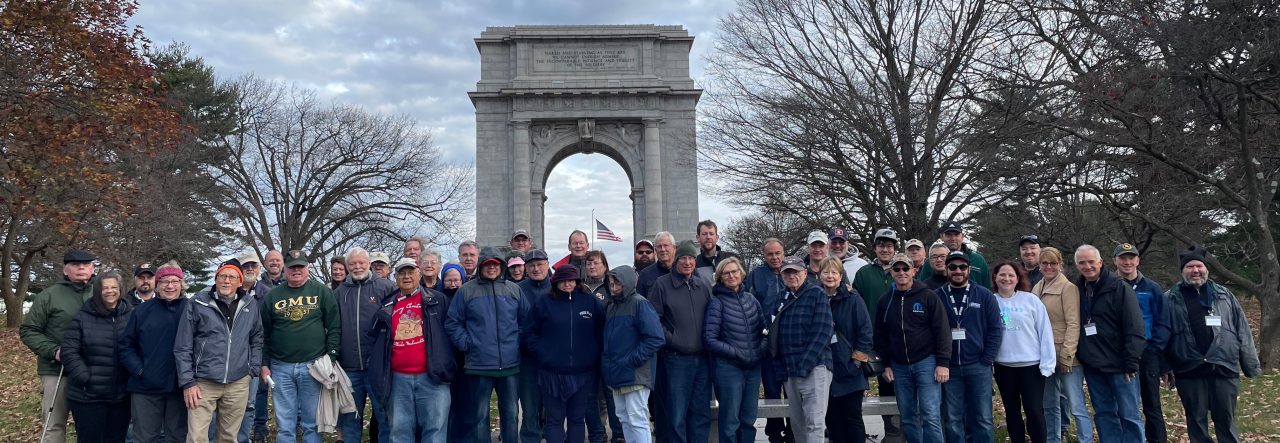
I know we’re getting close to the Cowpens battlefield when we pass Redcoat Drive and then Tory Trail. Unfortunately, my GPS takes us to the maintenance shed rather than the visitor center, but the park’s signage finally manages to get us where we need to go.
I know nothing about the battle of Cowpens, but my colleague Rob Orrison has strongly recommended I visit the battlefield. It involves some of the most colorful characters of the war, he tells me: Daniel Morgan and Banastre Tarleton. “The battle changed the course of the war in the Carolinas, in my humble opinion,” Rob adds.
That seems like a pretty ringing endorsement to me. My son and I, on our way back from Atlanta, decide to make the hop off I-85 for a visit.
 When we pull up to the visitor center, the full glare of sun seems to bleach the monument that stands outside. The heat and humidity add stillness to the scene. Leading up from the parking lot, the sidewalk is inscribed with key moments from the Carolinas campaigns, interspersed with logos for the “Overmountain Victory National Historic Trail.” Is an ingenious way to literally lead up to Cowpens.
When we pull up to the visitor center, the full glare of sun seems to bleach the monument that stands outside. The heat and humidity add stillness to the scene. Leading up from the parking lot, the sidewalk is inscribed with key moments from the Carolinas campaigns, interspersed with logos for the “Overmountain Victory National Historic Trail.” Is an ingenious way to literally lead up to Cowpens.
While a park loop road encircles the entire battlefield, much like a high school track surrounds a football field, only bigger, the drive does little justice to the battlefield. It seems like a little more than a large wobbly oval of black top with a couple parking areas that don’t reveal a whole lot. The first pull-off has a sign that essentially says, “This field was once a communal cowpasture, which is where the name ‘Cowpens’ comes from.” I initially—and naively—make the mistake of being underwhelmed.
The key to seeing the battlefield, I happily discover, is the walking path that winds from the visitor center through the core of the battlefield and along the Green River Road trace. The Green River Road brought Tarleton, on January 17, 1781, hellbent toward Morgan’s forces; Morgan deployed along the road to intercept. Tarleton, who earned a reputation as one of the truly despicable figures of the conflict because of his black-flag attitude, intended to crush patriot defenders—and their supporters on the homefront—at every possible opportunity.
However, Morgan established a brilliant three-line defense that made the best advantage of the assorted band of defenders he had with him. A preliminary line of sharpshooters comprised the first line of defense, tasked with harassing the British at long range. The second line consisted of militia, who similarly had exceptional long-range rifle skills. Because no one expected militia to stand up to British regulars, Morgan only asked them to each deliver two well-aimed shots “at killing distance” and then fall back. Morgan’s third line of defense consisted of battle-hardened veterans from the Continental Army. After the first two lines softened up the British, the Continentals would do the heavy fighting.
The plan worked brilliantly. At one point, when the British seemed poised to rout the Continentals, Morgan rode into the fray to redeploy his men and rally them. When it then seemed like British dragoons threatened to crush the flank of Morgan’s position, but the militia that had earlier fallen back rallied from the rear and launched a counterattack of their own to drive the horsemen from the field.
Tarleton’s entire forced crumbled, and Morgan’s decisive victory reinvigorated Continental hopes not only in the Carolinas but all across the colonies. According the NPS brochure, British k/w/m exceeded 940 men; Colonial casualties amounted to 24 killed and 104 wounded. It was, Morgan later boasted, a “devil of a whipping.” Rob wasn’t kidding when he told me this was a turning-point battle.
It’s a hot day to be out on the battlefield, but I’m glad I took the opportunity to break away from the driving tour and explore the interior of the battlefield. The well-maintained park makes it easy to see the landscape features Morgan based his battle plan around, and the walking paths wound through some beautifully primordial forests. Cowpens turned out to be a detour well worth taking.






It’s one of my favorite battles and it shows the leadership of Morgan and truly one of the great battlefield commanders during the war. He truly was one of the few generals who understood how to use the militia successfully.
LikeLike
Well told. Thanks.
LikeLike